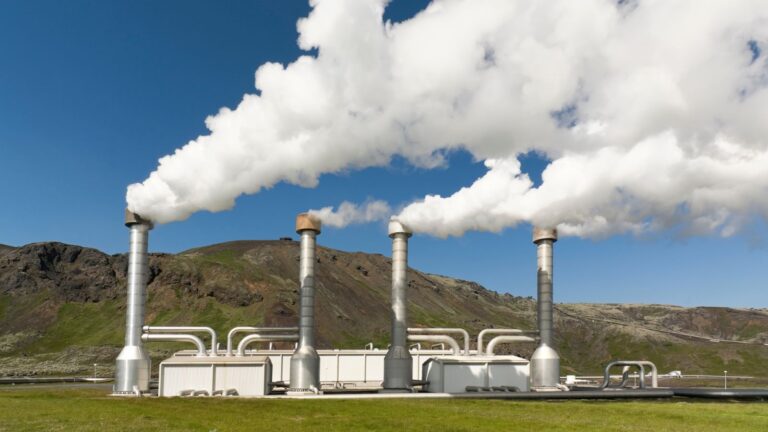This report represents the research and views of the author. It does not necessarily represent the views of the Center on Global Energy Policy. The piece may be subject to further revision. Contributions to SIPA for the benefit of CGEP are general use gifts, which gives the Center discretion in how it allocates these funds. More information is available at Our Partners. Rare cases of sponsored projects are clearly indicated. For a full list of financial supporters of the Center on Global Energy Policy at Columbia University SIPA, please visit our website at Our Partners. See below a list of members that are currently in CGEP’s Visionary Annual Circle.
-
CGEP’s Visionary Annual Circle
-
(This list is updated periodically)
Occidental Petroleum Corporation
EXECUTIVE SUMMARY
In the United States, commercial and residential buildings produce roughly 12 percent of greenhouse gas emissions. Most of these emissions come from burning fossil fuels for space heating. These emissions must be significantly reduced or eliminated for the US to achieve deep decarbonization goals, including net zero emissions by midcentury.
Air source heat pumps (ASHPs) are powered by electricity, using well-established technology to move heat from outdoor air to indoor air. When powered by zero-carbon electricity, ASHPs provide space heating with almost no greenhouse gas emissions. ASHPs are especially effective for space heating in mild climates.
In 2015, roughly 10 percent of US households (mostly in the Southeast) used air source heat pumps as their primary heating source.[1] ASHPs account for roughly one-third of residential space heating in Japan. The world’s largest ASHP market is in China, where sales are growing rapidly.
Prominent studies on decarbonization of the US energy system focus on deployment of air source heat pumps as the primary strategy for reducing emissions from space heating.
- Some studies show near-universal electrification of space heating, suggesting that ASHPs (with some backup from electric resistance heaters) can be almost a silver bullet solution for decarbonizing space heating. These studies start with the assumption that fossil fuel furnaces and boilers will be gradually phased out.
- Other studies assume that electric heating technologies such as ASHPs will continue to compete against fossil fuel burning furnaces and boilers in the decades ahead. These studies conclude that furnaces and boilers will retain a significant share in space heating markets, even with technological progress and strong policy support for ASHPs, but often fail to explain why. Do high costs or inferior performance limit market penetration in these studies? Or do other barriers limit ASHP deployment? The answer has important implications for policy makers shaping decarbonization strategies.
To help answer these questions, we built a simple model of ASHP adoption that estimates the lifetime costs of space heating and cooling configurations in three US cities with markedly different climates and energy costs: Atlanta, Georgia; San Diego, California; and Fargo, North Dakota. The model analyzes the choices facing hypothetical consumers installing new heating and cooling equipment in residential buildings. The consumers have the option to purchase an ASHP for heating and cooling (with backup if needed) or a natural gas furnace and air conditioner.
Based on the model results and related research, we conclude:
- Air source heat pumps are cost competitive today in places where electricity is cheap and the climate is mild.
- With climate policies consistent with rapid decarbonization and reasonably foreseeable technological progress, air source heat pumps are the low-cost option for typical residential buildings across much of the US by the mid-2030s. Even in the very cold climate of Fargo, North Dakota, the combination of a price on carbon emissions and steady innovation in ASHPs causes ASHPs (with an electric resistance heater as a backup) to be cost competitive with new natural gas furnaces and air conditioners by the 2030s.
If the United States commits to the rapid decarbonization of space heating by midcentury, the costs and performance of ASHPs are unlikely to be major barriers to deployment. However, other important barriers may persist, including contractors’ and homeowners’ greater familiarity with incumbent fossil fuel technologies and the slow turnover of the building stock.
As a result of these additional barriers, emissions pricing and technological progress alone may not lead to deployment of air source heat pumps in the United States sufficient to achieve deep decarbonization by midcentury. That would likely require additional policy instruments such as technology standards, emissions caps, or mandates.
Other technologies can also contribute to decarbonizing space heating, including renewable natural gas, hydrogen produced with carbon capture and storage (CCS) or electrolysis, and centralized or district heating. Each of these options comes with challenges that will require policy support to overcome.
This study does not point to a proper balance between ASHPs and other space heating decarbonization technologies. More research is needed to compare different approaches and strategies. In the meantime, our analysis suggests little if any downside to pursuing ambitious policies to promote deployment of ASHPs, prioritizing regions where heat pumps are currently most cost effective. A large-scale increase in ASHP deployments is likely to be an important part of any space heating decarbonization scenario.





